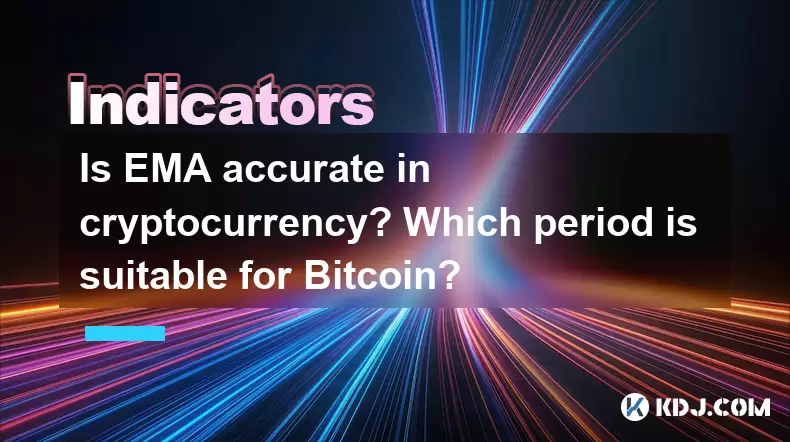-
 bitcoin
bitcoin $120167.907534 USD
1.27% -
 ethereum
ethereum $4468.611945 USD
2.53% -
 xrp
xrp $3.013607 USD
1.80% -
 tether
tether $1.000549 USD
-0.01% -
 bnb
bnb $1092.592149 USD
6.28% -
 solana
solana $231.391244 USD
4.59% -
 usd-coin
usd-coin $0.999699 USD
-0.04% -
 dogecoin
dogecoin $0.259020 USD
4.30% -
 tron
tron $0.342747 USD
0.34% -
 cardano
cardano $0.860977 USD
1.07% -
 hyperliquid
hyperliquid $50.155412 USD
5.34% -
 chainlink
chainlink $22.637678 USD
0.46% -
 ethena-usde
ethena-usde $1.000528 USD
-0.07% -
 avalanche
avalanche $30.613779 USD
-0.07% -
 stellar
stellar $0.403905 USD
0.94%
Is EMA accurate in cryptocurrency? Which period is suitable for Bitcoin?
EMA is favored in crypto trading for quickly identifying trends, but its accuracy can be impacted by market volatility and should be used with other indicators for best results.
May 21, 2025 at 03:57 pm

The Exponential Moving Average (EMA) is a popular technical analysis tool used by traders in the cryptocurrency market. EMA is valued for its ability to give more weight to recent price data, which can help traders identify trends more quickly than with the Simple Moving Average (SMA). However, the accuracy of EMA in the cryptocurrency market is a subject of debate among traders and analysts.
In this article, we will explore the accuracy of EMA in the cryptocurrency market, particularly for Bitcoin, and discuss which period might be suitable for Bitcoin trading. We will delve into the mechanics of EMA, its application in cryptocurrency trading, and the factors that can affect its accuracy.
Understanding EMA and Its Calculation
The Exponential Moving Average is calculated by applying more weight to recent prices. The formula for EMA is:
[ \text{EMA}{\text{today}} = (\text{Price}{\text{today}} \times \text{Multiplier}) + (\text{EMA}_{\text{yesterday}} \times (1 - \text{Multiplier})) ]
Where the Multiplier is calculated as:
[ \text{Multiplier} = \frac{2}{(\text{Time period} + 1)} ]
This method ensures that the EMA reacts more quickly to recent price changes compared to the SMA. The EMA's sensitivity to recent price movements makes it a preferred choice for many traders in the fast-paced cryptocurrency market.
Accuracy of EMA in Cryptocurrency Trading
The accuracy of EMA in cryptocurrency trading can vary based on several factors, including market volatility, trading volume, and the time frame used for analysis. In highly volatile markets like cryptocurrencies, the EMA can be a useful tool for identifying short-term trends. However, its accuracy can be affected by sudden price spikes or drops that are common in the crypto market.
Traders often use EMA in conjunction with other indicators to increase its accuracy. For instance, combining EMA with the Relative Strength Index (RSI) or the Moving Average Convergence Divergence (MACD) can provide a more comprehensive view of market trends. This approach helps traders mitigate the risks associated with relying solely on EMA for trading decisions.
Suitable EMA Periods for Bitcoin
Choosing the right EMA period for Bitcoin trading depends on the trader's strategy and time frame. Short-term traders might prefer shorter EMA periods, such as 9 or 12 days, to capture quick price movements. These periods are more sensitive to recent price changes and can help traders identify entry and exit points in the market.
For medium-term traders, a 26-day EMA might be more suitable. This period balances sensitivity to price changes with a broader view of the market trend. It can help traders identify longer-term trends while still reacting to significant price movements.
Long-term traders might opt for a 50-day or 200-day EMA. These periods provide a more stable view of the market and can help traders identify major trends in Bitcoin's price. The 200-day EMA, in particular, is often used as a benchmark for long-term trends in the cryptocurrency market.
Factors Affecting EMA Accuracy in Bitcoin Trading
Several factors can affect the accuracy of EMA in Bitcoin trading. Market volatility is a primary factor. Bitcoin's price can experience significant fluctuations in a short period, which can lead to false signals from the EMA. Traders need to be aware of these volatility spikes and adjust their strategies accordingly.
Trading volume is another crucial factor. High trading volumes can validate EMA signals, as they indicate strong market interest. Conversely, low trading volumes might result in less reliable EMA signals, as they could be influenced by fewer market participants.
The choice of time frame also plays a role in EMA accuracy. Different time frames can produce different EMA signals. For instance, a daily chart might show a different trend compared to a weekly or monthly chart. Traders should consider multiple time frames to get a more comprehensive view of the market.
Practical Application of EMA in Bitcoin Trading
To apply EMA in Bitcoin trading, traders can follow these steps:
- Choose the appropriate EMA period: Based on your trading strategy, select the EMA period that best suits your needs. Short-term traders might use a 9-day EMA, while long-term traders might opt for a 200-day EMA.
- Apply the EMA to your chart: Use trading software or platforms like TradingView to apply the EMA to your Bitcoin price chart. Ensure that you have selected the correct period for your analysis.
- Identify trends: Look for crossovers between the EMA and the price or between different EMA periods. For instance, if the price crosses above the EMA, it might indicate an uptrend. Conversely, if the price crosses below the EMA, it might signal a downtrend.
- Confirm signals with other indicators: Use additional technical indicators like RSI or MACD to confirm the EMA signals. This can help increase the accuracy of your trading decisions.
- Set entry and exit points: Based on the EMA signals and confirmation from other indicators, set your entry and exit points for Bitcoin trades. Ensure that you have a clear risk management strategy in place.
Limitations of EMA in Cryptocurrency Trading
While EMA can be a valuable tool for cryptocurrency traders, it has its limitations. One major limitation is the potential for false signals in highly volatile markets. The EMA's sensitivity to recent price changes can lead to whipsaws, where the price moves sharply in one direction and then reverses quickly.
Another limitation is the lag in EMA signals. Although the EMA reacts more quickly to price changes than the SMA, it still has a lag compared to real-time price movements. Traders need to be aware of this lag and adjust their strategies accordingly.
Lastly, EMA signals can be influenced by market noise. In the cryptocurrency market, where prices can be affected by news, social media, and other external factors, the EMA might not always provide accurate signals. Traders should consider these factors when using EMA for trading decisions.
Frequently Asked Questions
Q: Can EMA be used alone for trading decisions in the cryptocurrency market?A: While EMA can provide valuable insights into market trends, it is generally not recommended to use it alone for trading decisions. Combining EMA with other technical indicators can help increase its accuracy and provide a more comprehensive view of the market.
Q: How does the choice of EMA period affect trading strategy?A: The choice of EMA period directly impacts the sensitivity of the indicator to price changes. Shorter EMA periods, such as 9 or 12 days, are more sensitive to recent price movements and are suitable for short-term trading strategies. Longer EMA periods, like 50 or 200 days, provide a broader view of the market and are better suited for long-term trading strategies.
Q: Is EMA more effective in bull markets or bear markets for Bitcoin trading?A: EMA can be effective in both bull and bear markets, but its effectiveness can vary. In bull markets, EMA can help traders identify uptrends and potential entry points. In bear markets, EMA can signal downtrends and help traders identify exit points. However, traders should always consider the overall market context and use additional indicators to confirm EMA signals.
Q: How can traders minimize the impact of false signals from EMA in Bitcoin trading?A: To minimize the impact of false signals from EMA, traders can use multiple time frames for analysis, combine EMA with other technical indicators, and implement strict risk management strategies. Additionally, staying informed about market news and events can help traders anticipate potential price movements that might affect EMA signals.
Disclaimer:info@kdj.com
The information provided is not trading advice. kdj.com does not assume any responsibility for any investments made based on the information provided in this article. Cryptocurrencies are highly volatile and it is highly recommended that you invest with caution after thorough research!
If you believe that the content used on this website infringes your copyright, please contact us immediately (info@kdj.com) and we will delete it promptly.
- BlockDAG, DOGE, HYPE Sponsorship: Crypto Trends Shaping 2025
- 2025-10-01 00:25:13
- Deutsche Börse and Circle: A StableCoin Adoption Powerhouse in Europe
- 2025-10-01 00:25:13
- BlockDAG's Presale Buzz: Is It the Crypto to Watch in October 2025?
- 2025-10-01 00:30:13
- Bitcoin, Crypto, and IQ: When Genius Meets Digital Gold?
- 2025-10-01 00:30:13
- Stablecoins, American Innovation, and Wallet Tokens: The Next Frontier
- 2025-10-01 00:35:12
- NBU, Coins, and Crypto in Ukraine: A New Yorker's Take
- 2025-10-01 00:45:14
Related knowledge

What is a tower bottom candlestick pattern? Does it have a high success rate?
Sep 22,2025 at 07:18am
Tower Bottom Candlestick Pattern Explained1. The tower bottom candlestick pattern is a reversal formation that typically appears at the end of a downt...

What is a black hole pattern in the MACD indicator? Is it a cause for concern?
Sep 21,2025 at 06:54pm
Bitcoin's Role in Decentralized Finance1. Bitcoin remains the cornerstone of decentralized finance, serving as a benchmark for value and security acro...

How can I use the psychological line (PSY) to determine market sentiment?
Sep 17,2025 at 02:19pm
Understanding the Psychological Line (PSY) in Cryptocurrency TradingThe Psychological Line, commonly referred to as PSY, is a momentum oscillator used...

How can I determine if a double top pattern has officially formed?
Sep 21,2025 at 03:18am
Understanding the Structure of a Double Top Pattern1. A double top pattern consists of two distinct peaks that reach approximately the same price leve...

What is the Golden Valley pattern on the moving average? Is it better than the Silver Valley pattern?
Sep 21,2025 at 02:54pm
Understanding the Golden Valley Pattern in Moving Averages1. The Golden Valley pattern is a technical formation observed in cryptocurrency price chart...

What does a death cross of the RSI in the strong zone (above 50) mean?
Sep 17,2025 at 10:54pm
Understanding the Death Cross in RSI Context1. The term 'death cross' is traditionally associated with moving averages, where a short-term average cro...

What is a tower bottom candlestick pattern? Does it have a high success rate?
Sep 22,2025 at 07:18am
Tower Bottom Candlestick Pattern Explained1. The tower bottom candlestick pattern is a reversal formation that typically appears at the end of a downt...

What is a black hole pattern in the MACD indicator? Is it a cause for concern?
Sep 21,2025 at 06:54pm
Bitcoin's Role in Decentralized Finance1. Bitcoin remains the cornerstone of decentralized finance, serving as a benchmark for value and security acro...

How can I use the psychological line (PSY) to determine market sentiment?
Sep 17,2025 at 02:19pm
Understanding the Psychological Line (PSY) in Cryptocurrency TradingThe Psychological Line, commonly referred to as PSY, is a momentum oscillator used...

How can I determine if a double top pattern has officially formed?
Sep 21,2025 at 03:18am
Understanding the Structure of a Double Top Pattern1. A double top pattern consists of two distinct peaks that reach approximately the same price leve...

What is the Golden Valley pattern on the moving average? Is it better than the Silver Valley pattern?
Sep 21,2025 at 02:54pm
Understanding the Golden Valley Pattern in Moving Averages1. The Golden Valley pattern is a technical formation observed in cryptocurrency price chart...

What does a death cross of the RSI in the strong zone (above 50) mean?
Sep 17,2025 at 10:54pm
Understanding the Death Cross in RSI Context1. The term 'death cross' is traditionally associated with moving averages, where a short-term average cro...
See all articles










































































